A Gold Rush in the Ocean –Taiwan's Prowess in Pelagic Squid Fishery
◎English translation: Peng Hsin-yi
◎Photos by Huang Ching-wen
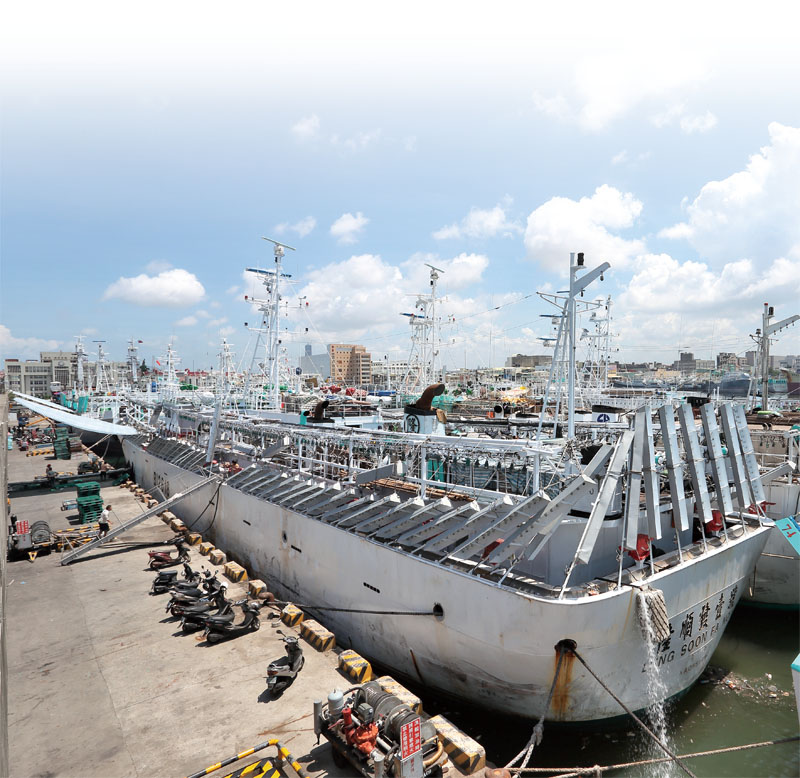
2015 has been a good year for Taiwan's pelagic squid fishery industry. After a voyage lasting 35 to 40 days, the ships finally docked at Cianjhen Fishing Port. Luck was on the side of the fishermen, as their total catch was around 220,000 tonnes.
Squid is one of the most popular and relatively inexpensive seafood items in Taiwan, but few people know how much work is involved in getting their favorite seafood to the table. For one thing, the fishing vessels have to travel far from the home, to fishing grounds in the Pacific, Atlantic and Indian Oceans. Taiwan currently ranks third in the world in terms of the volume of squid caught, behind China and Argentina. In addition to squid, Taiwan also makes the top three for tuna and Pacific saury, so Taiwan is truly a major player in the global pelagic fishery industry.
Cianjhen Fishing Port is the home base for all of Taiwan's pelagic fishing vessels. Different types of ships dock during different seasons. Right now it is the time for the squid fleet; when the port is at its busiest, ships need to triple park along the jetties. "Time is money" is the industry's mantra, and this is because, in pelagic fishing, everything has to be planned down to the smallest detail, and everything has to be done precisely to schedule. As soon as a ship docks, the catch is unloaded. Each vessel then gets ready for a voyage to the Northern Pacific for the Pacific saury season in the second half of the year.
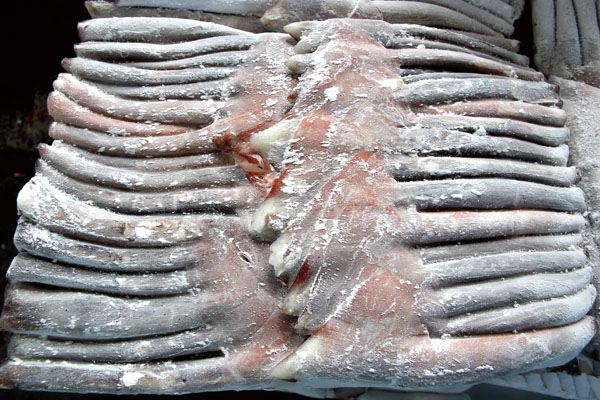 In recent years, Taiwan's squid ships have worked mostly in the Southwest Atlantic, in a fishing spot near the Falkland Islands known as the "Fisheries Gold Mine." Famed Argentine squid is the most significant fishing resource near the islands.
In recent years, Taiwan's squid ships have worked mostly in the Southwest Atlantic, in a fishing spot near the Falkland Islands known as the "Fisheries Gold Mine." Famed Argentine squid is the most significant fishing resource near the islands.
The UK government –which has sovereignty over the islands –has been trying to balance sustainability with commercial concerns. Back in 1986, it announced that an area 150 nautical miles in radius would become an ocean sanctuary, and created a quota limiting the number of ships allowed to fish in the waters. A ship must first obtain a license in order to legally fish within 150 nautical miles of the Falkland Islands.
Taiwan started fishing for squid near the islands as early as 1982, and once the licensing regulation was put in place in 1987, the Taiwanese fleet purchased a license immediately. Taiwan's fishing vessels have thus always been fishing legally within the sanctuary. A new regulation was announced earlier this year, limiting the squid season near the Falkland Islands to February 15 to May 15. So they could start work on the opening day of the fishing season, the fleet had to set out from Kaohsiung at the end of December 2014 – a perfect example of how the calendar dominates pelagic fishing.
Squid rest deep in the ocean during the day, then swim to the surface to feed at night, so squid fishermen need to work after dark. Once they have chosen where to fish, the ships stay at that location. Squid are attracted to light, so the ships are equipped with squid lights to lure them in. Squid are line fished, so plastic bait tied onto fishing lines is released into the water. When they are pulled up, the squid fall into a net, then into a gully installed at the side of the ship. Seawater runs through the gully, flushing the squid into the boat's storage area. There, the crew sort them by grade, then place them in the freezer at the vessel's aft. Later, the frozen squid are loaded onto a transporter and sent home, while the fishing ship stays behind to continue with the harvest. At night during squid season, the ocean around the Falkland Islands is brightly lit due to the large number of squid ships, most of which are from Taiwan or South Korea.
 When the squid season ends, most of the Taiwanese squid ships head home. The first wave of returning boats gets back to Cianjhen on June 18, where dock crews are waiting for them. The unloading starts as soon as the ships have docked. Conveyor belts connected to each ship roll out blocks and blocks of ice containing the precious catch. The fishing crews take pride in their work, as the evidence of six hard months on the high seas are transferred to dry land.
When the squid season ends, most of the Taiwanese squid ships head home. The first wave of returning boats gets back to Cianjhen on June 18, where dock crews are waiting for them. The unloading starts as soon as the ships have docked. Conveyor belts connected to each ship roll out blocks and blocks of ice containing the precious catch. The fishing crews take pride in their work, as the evidence of six hard months on the high seas are transferred to dry land.
Mr. Shi Jiao-ming, standing supervisor of the Taiwan Squid Fishery Association, says every little thing matters on a fishing ship, and the work does not stop at unloading the ship. Squid caught by Taiwanese boats are sold to China, Vietnam, Europe and the Americas. Depending on where they are going, they need different documentation. For example, exports to the EU, Vietnam, Russia and China all require a statement from Taiwan's authorities about the vessel which caught the squid. On top of that, Vietnam, Russia and China stipulate that all fishing vessels satisfy an additional health inspection conducted by the Bureau of Standards Metrology and Inspection, part of Taiwan's Ministry of Economic Affairs (MOEA). EU rules are the most stringent, as they require all ships pass the Inspection of Fishing Vessels Supplying Fishery Products for Export to the European Union. Also, the captain of the ship must be certified in health and hygiene training.
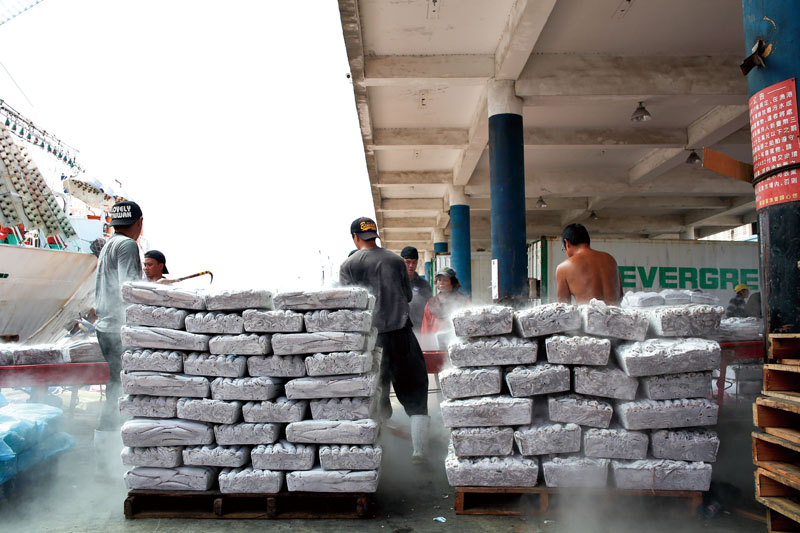 What is more, the MOEA requires all sites where produce for export is stored or processed to be certified as safe locations. These requirements are onerous, but certificates issued by the exporting country stating the product is safe to eat give consumers peace of mind, assuring them that each step in the entire process has been supervised and monitored for safety. In this sense, stringent demands are a good thing for Taiwan, because they push the fisheries industry to continue improving the quality of its products.
What is more, the MOEA requires all sites where produce for export is stored or processed to be certified as safe locations. These requirements are onerous, but certificates issued by the exporting country stating the product is safe to eat give consumers peace of mind, assuring them that each step in the entire process has been supervised and monitored for safety. In this sense, stringent demands are a good thing for Taiwan, because they push the fisheries industry to continue improving the quality of its products.
The pelagic fishing industry depends on and sustains a wide range of other industries: fuel supply; freezer storage; processing, supply and logistics; and shipbuilding. With such a support system, it is no wonder that Taiwan's pelagic fleet is one of the most respected in the world, welcomed in various international fishing organizations as a fishing entity, to sit at the negotiating table and speak on behalf of our fishermen and protect their rights.
Squid is a high-protein, low-fat seafood. It is rich in taurine, which reduces cholesterol buildup on the walls of blood vessels. The fats in squid are unsaturated fats such as EPA and DHC, so those who love seafood can enjoy this delicacy without feeling guilty. There are many ways to enjoy this bounty of the sea: Grilled whole; sliced and flash fried; boiled; stir fried; or deep fried. It is good for both your body and your wallet.
海裡的淘金熱 台灣遠洋魷魚產業實力
◎文/侯雅婷
◎攝影/黃敬文
幸運之神的眷顧,今年是台灣魷釣船滿載阿根廷魷的豐收年!歷經35至40天的航行,捕獲約22萬噸的魷魚,風塵僕僕地返回高雄前鎮漁港。
魷魚是最為國人熟悉,喜愛的平價海鮮之一,但少有消費者意識到,捕魷魚工程浩大,魷釣船隊萬里迢迢征戰漁場,現今,台灣遠洋魷釣船魷魚捕撈量位居全球第三大,僅次於中國、阿根廷;台灣遠洋漁船作業漁場遍及世界三大洋,其中鮪魚、秋刀魚和魷魚捕撈量名列全球前三名,遠洋漁業實力傲視全球。
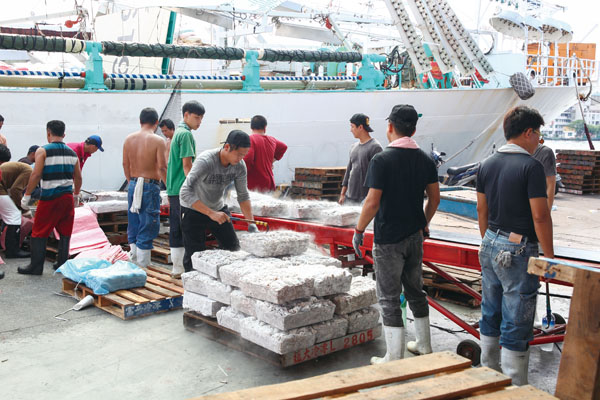 前鎮漁港是台灣遠洋漁船基地,在不同時節,泊靠不同類型的船隻,這陣子,魷釣船返港卸漁獲,尖峰時期,港邊漁船甚至多到得並排三列。遠洋漁業的步調始終精準、緊湊,「時間就是金錢」這句老話在這被印證著,返港的魷釣船忙著卸貨、整補並更換設備,準備7月啟程至西北太平洋海域捕撈秋刀魚,超過9成的台灣魷釣船上半年捕魷魚,下半年兼捕秋刀魚。
前鎮漁港是台灣遠洋漁船基地,在不同時節,泊靠不同類型的船隻,這陣子,魷釣船返港卸漁獲,尖峰時期,港邊漁船甚至多到得並排三列。遠洋漁業的步調始終精準、緊湊,「時間就是金錢」這句老話在這被印證著,返港的魷釣船忙著卸貨、整補並更換設備,準備7月啟程至西北太平洋海域捕撈秋刀魚,超過9成的台灣魷釣船上半年捕魷魚,下半年兼捕秋刀魚。
近年來,台灣魷釣船隊集中在西南大西洋附近、素有「漁業界金礦」之稱的英屬福克蘭群島水域捕釣阿根廷魷魚,阿根廷魷是福克蘭群島漁獲量最大的漁獲,握有豐沛魷魚資源的福克蘭群島政府致力探勘沿海漁業和商業資源的永續捕撈與開發,於1986年宣布150浬海域為保護區,對於進入海域捕魚的漁船採配額限制,所有進入保護區內作業的漁船得申請購買作業執照才能在福克蘭群島150浬海域捕魚,福克蘭群島自次(1987) 年開始收取作業執照。台灣魷釣船船隊早於1982 年開始開發西南大西洋海域福克蘭群島的魷釣漁場,自1987年起,向福克蘭群島申請購買作業執照,進入福島150浬經濟海域保護區內作業。此外,福克蘭群島對於阿根廷魷魚採取限期政策,今年阿根廷魷魚捕撈時期為2月15日至5月15日,而為了趕上今年2月15日起跑的阿根廷魷魚捕撈 ,台灣魷釣船自去(2014)年12月底便啟程,遠洋魷釣漁船縝密的行程由此可見一般。
順著魷魚白天在深海休息、夜間浮至上層覓食的特性,魷釣船都於夜間作業,魷釣船探測魷魚群位置後,定位作業地點,利用魷魚的趨光性,透過集魚燈照射吸引魷魚群聚集船邊,釣魚線上裝有許多塑膠假餌誘捕魷魚,當釣魚線順著滾輪往上揚時,一尾尾的魷魚就落入網台,再順勢滑進船邊裝設的導槽內,導槽內裝置的海水將魷魚沖入船艙內,船員將漁獲分級後送至船艙冷藏凍結,再將漁獲交予運搬船輸出漁獲,魷釣船留在當地繼續捕釣魷魚,夜間福克蘭群島魷釣船隊燈火通明,大部分的魷釣船來自台灣和韓國,繼續一場場的捕魷競賽。
隨著阿根廷魷魚捕撈時期接近尾聲(5月15日),台灣的魷釣船船隊陸續返回前鎮漁港,今年自6月18日起,遠征福克蘭群島捕釣阿根廷魷魚的魷釣船隊陸續返航卸漁獲時,等在港邊的工作團隊身手俐落、有條不紊地動了起來,輸送帶上一塊塊高品質的凍魷塊是魷釣船船隊半年來海上拼搏的成果。
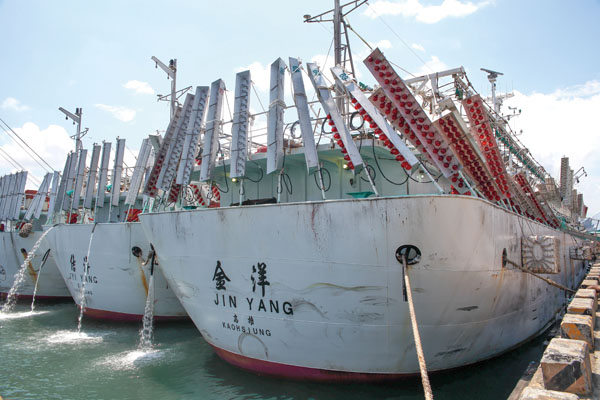 台灣區遠洋魷漁船魚類輸出同業公會常務監事施教明表示,魷釣船上每個作業環節都至關重要,而台灣捕獲的魷魚主要出口至中國大陸、越南、歐美等國,簡而言之,視出口國家得提供不同的證明文件,比如歐盟、越南、俄羅斯和中國大陸均需我國官方事先提報漁船名單,再者我國提報給越南、俄羅斯和中國大陸等國的漁船均需通過我國「經濟部標準檢驗局」的衛生評鑑;出口歐盟漁產品的漁船要求最為嚴格,得通過輸歐盟衛生管理評鑑合格漁船核定且船長得領有衛生教育訓練合格證書;如從台灣出口漁產品至歐盟、越南和俄羅斯得取得我國「經濟部標準檢驗局」開具的衛生證明,而經濟部標準檢驗局要求出口的加工廠和存放的倉儲廠必須經過該局事先驗證通過。來自漁產品出口國的衛生證明等同來自消費端對遠洋漁船諸多作業環節的管理和品質衛生把關,促使台灣遠洋船隊不斷提升漁產品品質。
台灣區遠洋魷漁船魚類輸出同業公會常務監事施教明表示,魷釣船上每個作業環節都至關重要,而台灣捕獲的魷魚主要出口至中國大陸、越南、歐美等國,簡而言之,視出口國家得提供不同的證明文件,比如歐盟、越南、俄羅斯和中國大陸均需我國官方事先提報漁船名單,再者我國提報給越南、俄羅斯和中國大陸等國的漁船均需通過我國「經濟部標準檢驗局」的衛生評鑑;出口歐盟漁產品的漁船要求最為嚴格,得通過輸歐盟衛生管理評鑑合格漁船核定且船長得領有衛生教育訓練合格證書;如從台灣出口漁產品至歐盟、越南和俄羅斯得取得我國「經濟部標準檢驗局」開具的衛生證明,而經濟部標準檢驗局要求出口的加工廠和存放的倉儲廠必須經過該局事先驗證通過。來自漁產品出口國的衛生證明等同來自消費端對遠洋漁船諸多作業環節的管理和品質衛生把關,促使台灣遠洋船隊不斷提升漁產品品質。
遠洋漁業產業鏈相關層面既深且遠,帶動國內週邊產業發展,包括冷凍倉儲、加工、物資補給和修造船業等;至於國外方面,台灣遠洋漁船素質、管理以及在各海域作業表現良好,使得台灣遠洋漁業得以捕魚實體(fishing entity)名義參與國際區域性漁業管理組織的協商談判,保障漁民權利。
魷魚是高蛋白質、低脂肪的海鮮,魷魚肉富含牛磺酸,可有效減少血管壁累積的膽固醇,而魷魚脂肪裏富含不飽和脂肪酸,例如EPA和DHA,消費者不妨多多食用,無論是霸氣的整尾烤魷魚乃至煎、煮、炒、炸各式料理,魷魚堪稱是最營養、平價的海味珍饈。